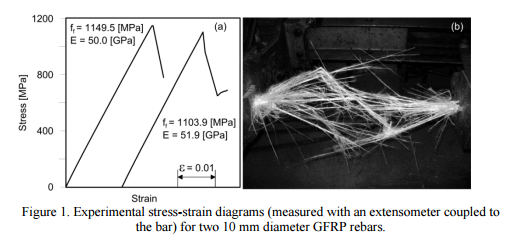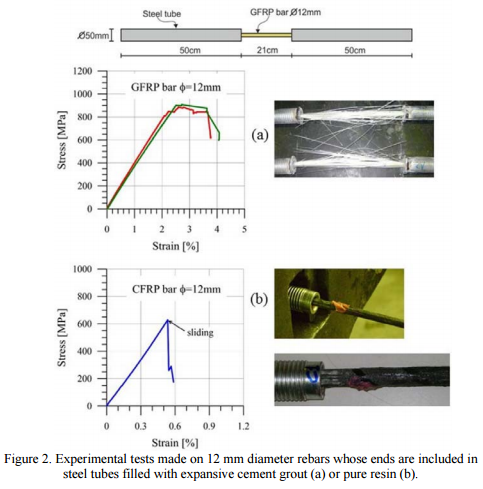GFRP BARS FOR INTERNAL REINFORCEMENT OF CONCRETE STRUCTURES
From: STUDIES AND RESEARCHES – V.34, 2015 Graduate School in Concrete Structures – Fratelli Pesenti Politecnico di Milano, Italy
GFRP BARS FOR INTERNAL REINFORCEMENT OF CONCRETE STRUCTURES
Giulia Fava1 , Massimiliano Bocciarelli2 , Valter Carvelli2 , Marco Andrea Pisani3 , Carlo Poggi3
1 Assistant Professor – Department of Architecture, Built Environment and Construction Engineering – ABC, Politecnico di Milano, Milan (Italy). 2 Associate Professor, Department of Architecture, Built Environment and Construction Engineering – ABC, Politecnico di Milano, Milan (Italy). 3 Professor, Department of Architecture, Built Environment and Construction Engineering – ABC, Politecnico di Milano, Milan (Italy).
ABSTRACT
This paper presents the activities developed at Politecnico di Milano that deal with the use of glass fibre reinforced polymers (GFRP) rebars for the internal reinforcement of concrete structural elements. Problems related to experimental characterization of the rebars, to bond of GFRP rebars and concrete, to fatigue of GFRP reinforced slabs and to the effect of elevated temperature on GFRP reinforced beams are discussed after showing the outcomes of the experimental tests conducted. All these studies support the view that GFRP rebars can be used profitably in some structural elements particularly exposed to corrosion.
1. INTRODUCTION
Steel rebars are the tension device usually adopted worldwide in reinforced concrete. There are anyway few special conditions where the adoption of GFRP (Glass Fibre Reinforced Polymer) rebars can be advantageous (Rostàsy et al, 1993; Bakis et al, 2002). GFRP rebars are commonly adopted in Tunnel Boring Machine “soft-eye” openings for launch and reception because of their brittleness and weakness when impacted by the cutting shield of the TBO Nevertheless, the main application of these rebars refers to structural elements in severe environmental conditions.
This is due to the excellent corrosion resistance to salt water of GFRP rebars have and the good behaviour at low temperature. Because of this, GFRP rebars could be adopted to increase durability of concrete structures exposed to de-icing chlorides, i.e.:
- bridge decks and railings,
- median barriers,
- approach slabs,
- salt storage facilities,
- continuously reinforced concrete paving,
- some precast elements like culverts and rail grade crossings, or to marine chlorides, that is:
- sea walls, wharfs, quays and dry docks,
- coastal construction exposed to salt fog,
- desalinization intakes,
- port aprons.
Canadians build bridge slabs reinforced with GFRP rebars from the early nineties (see Mufti et al, 2008 and Pendhari et al, 2008) and the advantages of these composite rebars have been already demonstrated, although some aspects concerning for instance bond to concrete, durability of the rebars, fatigue behaviour and reaction to fire still need more in-depth investigation. This paper is intended to describe the research carried out and experience gained at Politecnico di Milano on this particular type of rebar.
2. MATERIALS EXPERIMENTAL CHARACTERIZATION
The manufacturing technique generally adopted to produce fibre reinforced polymer rebars is pultrusion: the fibres are taken directly from the rovings and conveyed to a resin bath where impregnation occurs. Bundles of impregnated fibres enter the heating die where the material is formed.
The thermosetting resin is then hardened by means of heating (generally supplied by electrical resistances and the temperature is controlled by means of thermocouples). Upon exiting from the heating die, the matrix is cured and the composite is pulled at a constant speed. At the end of the process the material is cut to the appropriate length. The tensile behaviour of a GFRP rebar is elastic/brittle, as shown in Figure 1a.

The failure pattern shown in Figure 1b is typical of GFRP unidirectional composites under longitudinal tension, as it depends on the following statements: • the fibres do not break at the same cross section of the bar, • when the bar collapses, the fibres suddenly contract, • this dynamic effect compresses the resin matrix which transversally expands and finally breaks because of its low strength, • after failure “glass/epoxy shows extensive interfacial debonding associated with the relatively high ultimate strain of the glass fibre” (see Daniel, 1994) and the broken fibres are fan-shaped. Since the mechanical properties of the resin are much lower than those of the glass fibre (the elastic modulus is about 20 times lower, and the tensile strength is about 100 times lower) it is evident that the mechanical behaviour of the rebar is markedly orthotropic. Because of this, the experimental evaluation of the tensile strength of FRP bars is made difficult for the anchoring of the specimen to the testing machine: when the tensile force increases during the test, the shear and/or radial stresses increase in the anchorages. The strong anisotropy of the GFRP rebars (that involves low values of their shear and radial strength) makes it difficult to design an efficient anchorage and this difficulty increases together with the cross section area of the specimen (see ACI 440.1R-06 and ACI 440.3R-04). When referring to this problem ISO TC 71 and JSCE (1997) simply state that the anchorage shall be suited to the geometry of the test pieces, and shall have the capacity to transmit only the tensile force along the longitudinal axis of the test pieces. Some standard (ASTM D7205) and guidelines (ACI 440.1R-06 and CNR-DT 203) suggest placing a steel tube filled with pure resin, resin mixed with sand, or expansive cement grout (see Figure 2), around the ends of the specimen. However, ACI 440.1R-06 states that the anchor system they suggest ‘‘is not recommended for testing FRP bars that require more than 400 kN of load to fail the specimen’’. It has anyway to be stated that it is really difficult to obtain reliable, replicable experimental results even when dealing with bars of small diameter. This is because of many factors including the ratio between the elastic modules of the steel tube, the rebar and the material used for grouting, the thickness of the latter and also its ability to adhere to the other two (see Figure 2)

To evade this problem, the manufacturers declare a guaranteed strength or the nominal strength (that is the theoretical strength computed on the amount of fibre in the composite volume). The guaranteed strength is an uncertain data as far as there is not a standard reliable testing method to determine strength of these bars. The nominal strength is meaningless because the bar strength strongly depends on the resin adopted, the manufacturing method (that governs the parallelism and distribution of the fibres inside the polymeric matrix) and the bar diameter (ACI 440.1R-06 states that ‘‘GFRP bars from three different manufacturers show tensile strength reductions of up to 40% as the diameter increases proportionally from 0.375 to 0.875 in.’’). To overcome these difficulties a new anchor system that makes it possible tension testing of large diameter GFRP bars in a universal testing machine was developed (Carvelli et al, 2009 and Fava et al, 2012).
... follow ... Please read the attached article
